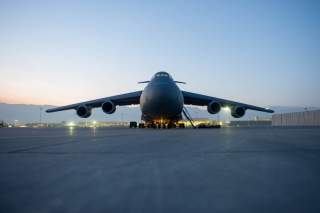Smokey the Bear Says: Let the U.S. Air Force Bomb Forest Fires
No, not with smart bombs or laser-guided missiles.
Attention, U.S. Air Force: Smokey the Bear needs air support.
2016 has been a bad year for the furry fire marshal. With many parts of the world suffering from record heat and drought (the thermometer hit 129 degrees Fahrenheit in northwest Kuwait in July), wildfires have been erupting around the globe. The Western United States, especially California, has been particularly hard hit, with 35 uncontained fires reported in August alone. By now, the scenes have become familiar: the burning trees, the residential homes just a firebreak away from destruction, the thin lines of overworked and exhausted firefighters.
But a California company has an idea for putting out wildfires: have the Air Force bomb them.
No, not with smart bombs or laser-guided missiles, silly. Remember what Smokey the Bear says: Please don't carpet bomb forests. In fact, what the Air Force would drop is nothing more than giant water balloons.
The Precision Container Aerial Delivery System, or PCADS, is the brainchild of William Cleary, a Boeing aircraft engineer who got the idea 13 years ago after his young son dropped a water balloon on him from a third-floor window. Like the apple landing on Isaac Newton's head, the knock on Cleary's noggin inspired him to wonder if forest fires could be extinguished by parachuting boxes of water on top of them.
PCADS consists of pallets of triple-walled corrugated cardboard boxes, each containing a 250-gallon biodegradable polyurethane bladder filled with water or fire retardant gel. The container has a pyrotechnic fuse timed to burst at least 300 feet above the ground, spreading the water over a large area.
PCADS, which is being marketed by California-based Flexible Attack Innovations (Boeing is no longer involved with the project), can be used with any transport that uses the Container Delivery System, or CDS, which the U.S. military has used as far back as the Korean War to parachute supplies. This includes many military transport aircraft, including C-130s, C-17s, C-27s, V-22s, CH-53 helicopters and even Russian IL-76s and IL-78s.
Airtankers are the air cavalry of firefighting, able to deploy rapidly to remote areas in support of the firefighters on the ground. Yet the U.S. Forest Service only has about 20 in service for the United States. Operated by private contractors, the fleet is comprised of a motley collection of converted civilian airliners and retired 1950s military aircraft, several of which have crashed over the years.
The Pentagon does help out, but very little. Upon request, it will deploy the Modular Airborne Fire Fighting Systems, or MAFFS, which are Air National Guard and Air Force Reserve C-130s fitted with nozzles to spray fire-extinguishing chemicals. The problem there is that there are only eight of them for the entire United States, and one Air National Guard C-130 pilot told me it takes too long for states to get federal permission to use MAFFS.
PCADS is designed to take advantage of two facts. First, PCADS requires accurately parachuting cargo, and who does that better than the U.S. military? Second, while the Forest Service may have 20 aircraft, the U.S. Air Force's Air Mobility Command has approximately 222 C-17s and 346 C-130s, with well-trained crews and computerized, GPS-guided navigation and paradrop systems. Those aircraft can switch from their regular military duties to firefighting and back again with little delay. Because as far as the transport crews are concerned, what's going out the cargo door is just another load, like all the other supplies they drop on combat zones and disaster areas.
In fact, some Air National Guard pilots say PCADS is actually safer than conventional airtankers. Unlike regular tankers that must fly hazardous low-altitude runs in rugged terrain to drop fire suppressant, PCADS can be dropped from altitudes of 1,000 feet or higher.
PCADS was conceived by Cleary 13 years ago, but still isn't being used. The Forest Service says it is aware of PCADS, but nothing more. The Air Force has certified it for use on its transport aircraft, but hasn't actually adopted it.
One reason may be safety, at least for those on the ground. Conventional air tankers drop liquids. PCADS drops 2,000-pound boxes fused to detonate in mid-air: if they don't, than a one-ton projectile may land on someone's house or head. Youtube has plenty of videos of what happens when cargo parachutes don't open.
There is also the question of how much the Pentagon should be diverted from fighting wars to fighting fires. Yet 2015 was a record fire season, with 68,151 fires burning almost 16,000 square miles. Osama bin Laden in his wildest dreams couldn't imagine inflicting that much damage.
As Smokey the Bear might say: We need the Air Force to stop forest fires.
Michael Peck is a contributing writer for the National Interest. He can be found on Twitter and Facebook.
Image: A C-5 Galaxy sits on the flightline as the sun sets prior to a sortie at Bagram Airfield, Afghanistan. Flickr/U.S. Air Force

